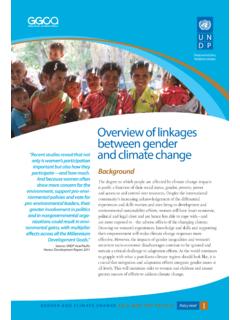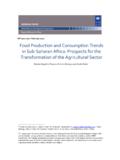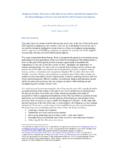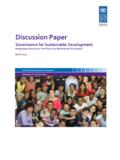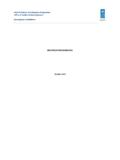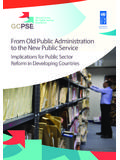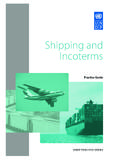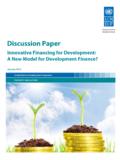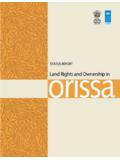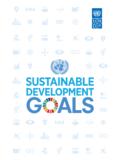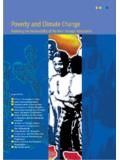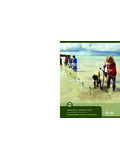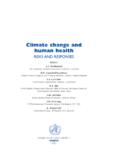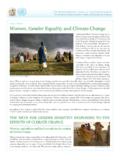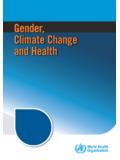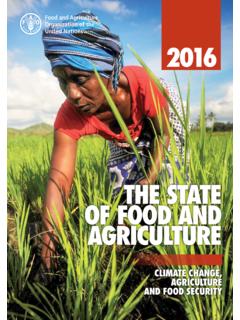Transcription of Disaster Risk Assessment - UNDP - United Nations ...
1 The starting point for reducing Disaster risk .. lies in the knowledge of the hazards and the physical, social, economic and environmental vulnerabilities .. and of the ways in which hazards and vulnerabilities are changing in the short and long term, followed by action taken on the basis of that knowledge. Hyogo Framework for Action 2005-2015 Understanding the interaction of hazards, exposure and vulnerability is crucial to effective Disaster prevention. Risk assessments are therefore fundamental to UNDP s work on Disaster risk reduction (DRR) and recovery.
2 WHAT IS RISK Assessment ?WHAT IS RISK Assessment ? UNDP defines risk as the probability of harmful consequences casualties, damaged property, lost livelihoods, disrupted economic activity, and damage to the environment resulting from interactions between natural or human-induced hazards and vulnerable conditions. Risk Assessment is a process to determine the nature and extent of such risk, by analyzing hazards and evaluating existing conditions of vulnerability that together could potentially harm exposed people, property, services, livelihoods and the environment on which they depend.
3 A comprehensive risk Assessment not only evaluates the magnitude and likelihood of potential losses but also provides full understanding of the causes and impact of those losses. Risk Assessment , therefore, is an integral part of decision and policy-making processes and requires close collaboration among various parts of society. UNDP APPROACHUNDP APPROACH Besides the estimation of potential losses and their impact, risk Assessment allows for the determination of the acceptable level of risk, defined as the level of losses that is acceptable without destroying lives, national economy or personal finances.
4 Once the current and acceptable levels of risk are determined, Disaster risk reduction plans and strategies could be revised or developed so that they have the measurable goal of reducing the current risk to acceptable levels. For countering existing Disaster risk systematically, for example by formulating a comprehensive DRR policy, developing land-use plans or putting in place insurance mechanisms to transfer non-reducible risks , the knowledge and understanding provided by a comprehensive risk Assessment are fundamental.
5 Furthermore, when the plans are being implemented, periodic evaluations of risk provide an explicit indication of progress in risk reduction. Bureau for Crisis Prevention and Recovery Disaster Risk Assessment For UNDP, a comprehensive risk Assessment consists of the following steps: Step 1: Understanding of current situation, needs and gaps to assess what already exists, avoid duplication of efforts, and build on existing information and capacities. This is done through a systematic inventory and evaluation of existing risk Assessment studies, available data and information, and current institutional framework and capabilities !
6 Step 2: Hazard Assessment to identify the nature, location, intensity and likelihood of major hazards prevailing in a community or society ! Step 3: Exposure Assessment to identify population and assets at risk and delineate Disaster prone areas ! Step 4: Vulnerability analysis to determine the capacity (or lack of it) of elements at risk to withstand the given hazard scenarios ! Step 5: Loss/impact analysis to estimate potential losses of exposed population, property, services, livelihoods and environment, and assess their potential impacts on society ! Step 6: Risk profiling and evaluation to identify cost-effective risk reduction options in terms of the socio-economic concerns of a society and its capacity for risk reduction !
7 Step 7: Formulation or revision of DRR strategies and action plans that include setting priorities, allocating resources (financial or human) and initiating DRR programmes !Tools for conducting Disaster risk assessments at both national and local levels UNDP differentiates between two levels of risk assessments: national and local risk assessments. A national risk Assessment is a strategic risk Assessment that supports the design of national DRR strategies, policy and regulations, DRM programming, and budget allocation. A local risk Assessment is an operational risk Assessment for DRR action planning, contingency planning, pre- Disaster recovery planning, and proper urban planning.
8 UNDP provides specific methodologies and tools to conduct multi-hazard risk Assessment at national and sub-national levels; guidance on multi-hazard urban risk Assessment in major cities and on impact Assessment of climate change at the national level; support to its partners on assessing the capacities of existing departments, identifying gaps, proposing and helping install mechanisms to address such gaps; and assistance in the establishment of community-based Disaster management committees to conduct risk Assessment in pilot regions.
9 Build national Disaster observatories (NDO) A NDO is a sustainable local institution that systematically collects, compiles and interprets historic Disaster information. A NDO helps the countries to learn from their Disaster history and incorporate that knowledge into the national DRR strategy and the implementation of Disaster risk management activities. knowledge and understanding provided by a comprehensive risk Assessment are fundamental. Furthermore, when the plans are being implemented, periodic evaluations of risk provide an explicit indication of progress in risk reduction.
10 They help to evaluate the effectiveness of Disaster risk reduction efforts and make the necessary corrections to the plans and strategies. UNDP SUPPORT SERVICESUNDP SUPPORT SERVICES Risk Assessment is an important component of UNDP Disaster risk reduction projects and programmes. Examples of the multifaceted activities implemented by UNDP include: National and local capacities for risk Assessment The main focus of UNDP s work is on capacity development. In the area of risk Assessment , UNDP provides technical assistance on the establishment of Disaster risk Assessment and institutional arrangements at the national level; supports the Assessment of hazard monitoring and mapping capacities and gap identification; supports local government on risk assessments for areas of resettlement and recovery after a Disaster .
